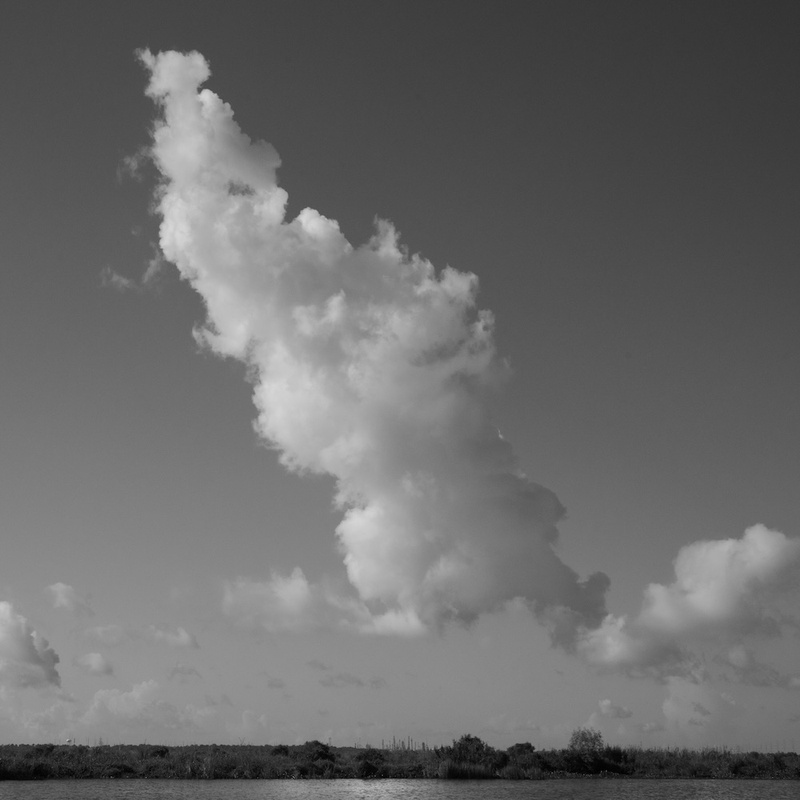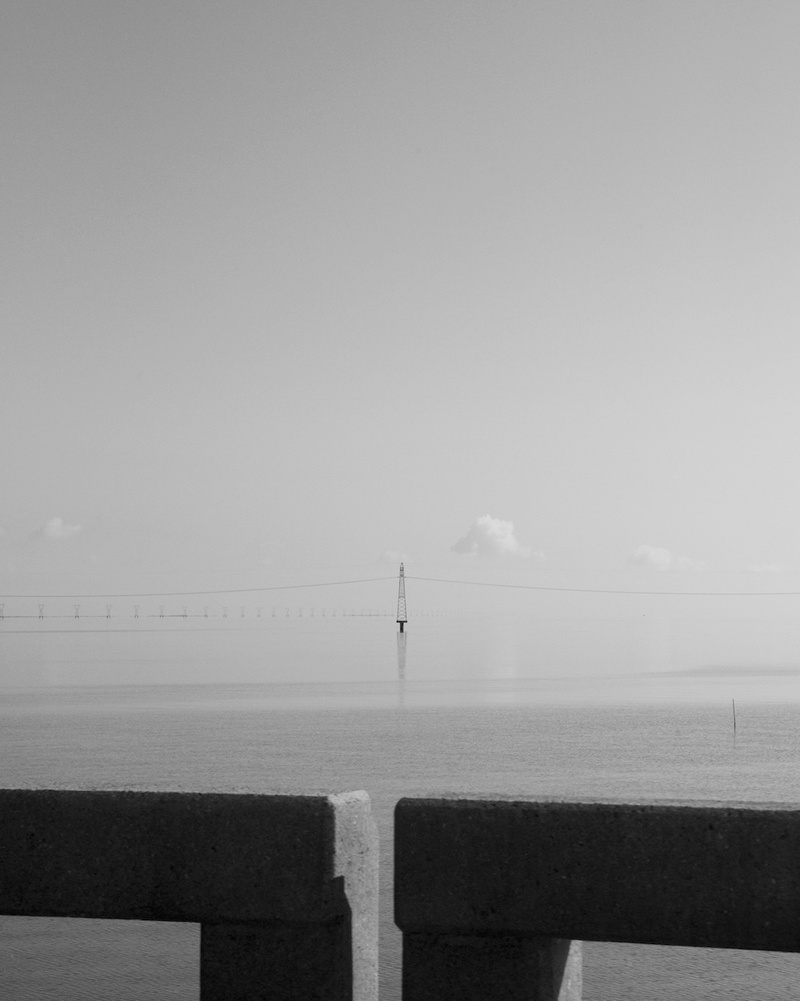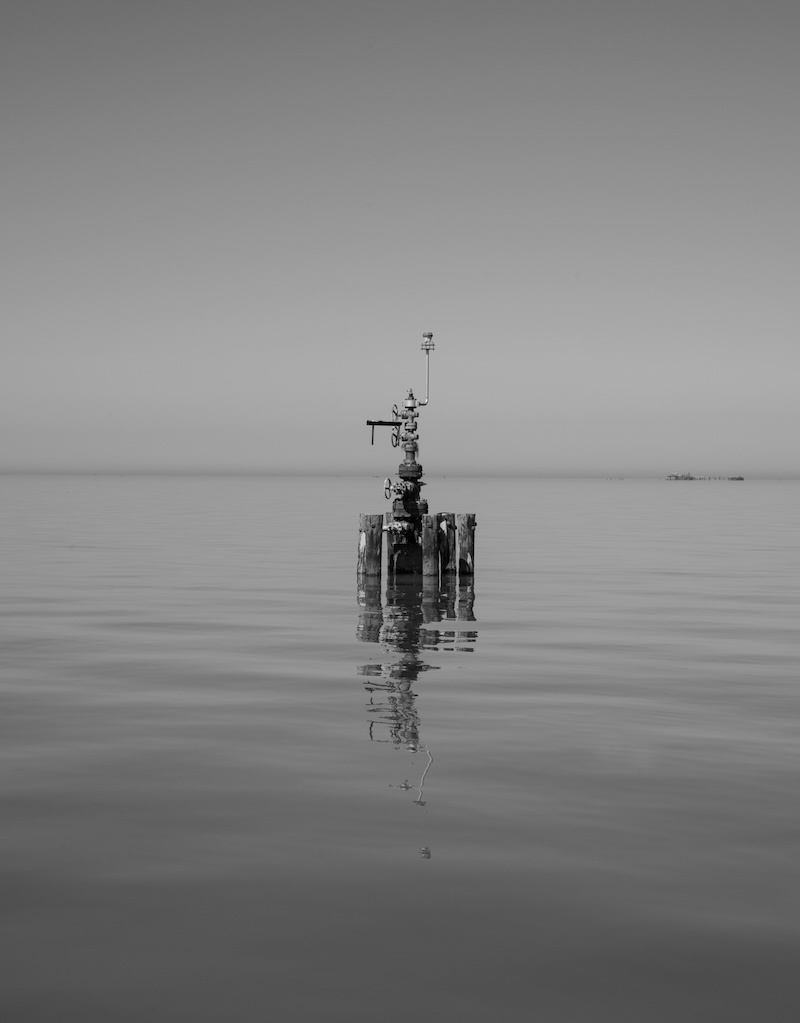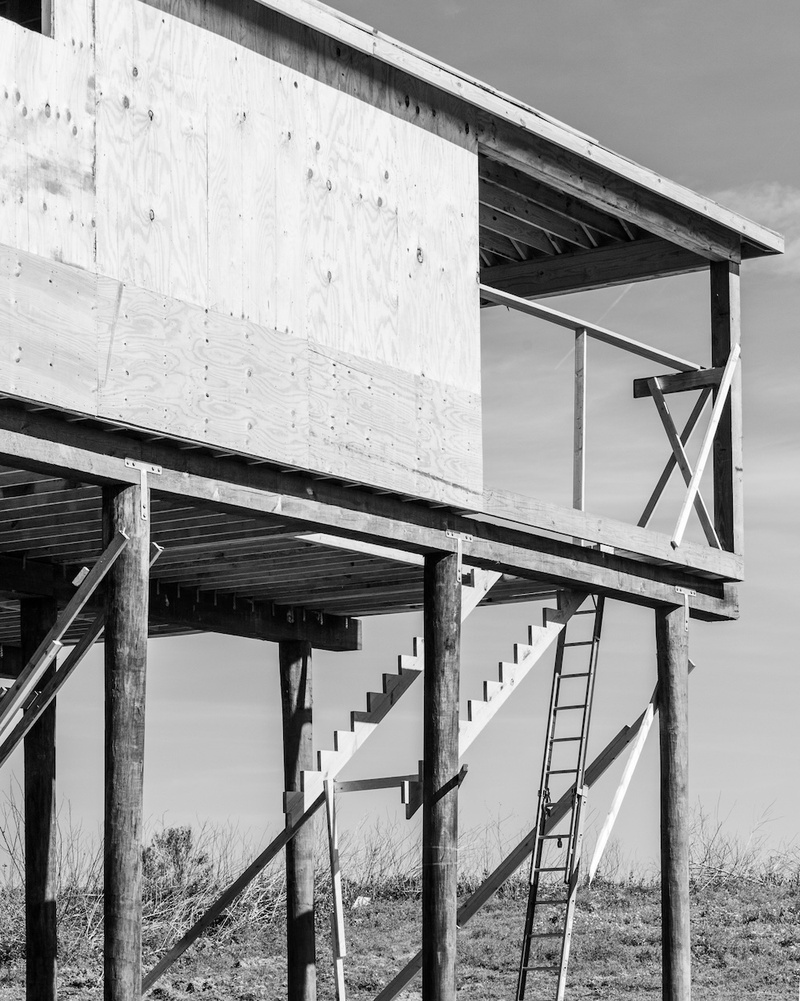Elevated Route 1 over Leeville
I’m familiar with your work as a photographer, but I notice you specifically call yourself an “artist and writer.” I’m wondering how you came to name yourself that?
It’s less of an intentional description of my own work versus wanting to be open to different mediums that I work with. I primarily work in photography, but I want to continue to pursue new projects and explore different ways of communicating and talking about the themes and issues that I’ve been exploring in my work for the past several years. My visual work blends with my writing a lot of the time, so for me, it’s more of an all encompassing type of practice that isn’t limited to photography.
How did the relationship to your art practice and the photography medium start?
I went to Bard, and I was studying their version of architecture. At the time they didn’t have a [formal] architecture program, so I was studying architectural theory and planning. All conceptual stuff, no actual studio, no hands on drawing or anything like that. I needed to fulfill an art requirement to graduate and I ended up enrolling into a photography class for non-majors.
The Bard photography department is just so spectacular, and world renowned, for good reason. An-My Lê taught my photo for non-majors course, who is one of the best photographers in the world. I loved the class so much that as a Senior, I petitioned to get into Stephen Shore’s 4x5 class. I was grateful to be able to find that medium, it was a perfect way of blending the way that I see the world and think about the built environment. I got into it just by chance. But once I found it, it was something that stuck with me. I think when you find the tool of understanding the world, it sticks with you. I was so fortunate to find that at a young age.
Chalmette Refinery, St. Bernard Parish
You’ve explicitly stated on your website that your work, “explore[s] the relationship between landscape, culture, and the built environment.” I know you grew up in New York and are currently based in Louisiana and your work really focuses on climate change and extraction, so I’m wondering how you came to focus on these topics and these regions?
[The Hudson River Valley] had a lasting impact in how I view landscape and our interactions with nature. I came from a place that was the beginnings of American nation building through landscape and where tourism in this country originally started. I think I had an early understanding and witness[ed] the ways the landscape is manipulated and marketed for a particular reason. I also grew up in a very blue collar working-class family. My whole family has worked in the building trades their whole lives. I have this deep respect for the hidden and invisible work that goes into architecture.
When I was at Bard I was in an organization that started after Hurricane Katrina by a student from New Orleans that would take groups down during the summer and winter break to intern and volunteer at different organizations in New Orleans. I was introduced to the city that way.
How am I gonna tie this back to the Hudson Valley…The Hudson Valley is extracted, not necessarily for its natural resources, but for leisure and there’s a tourism economy that fuels that place. Louisiana also has a tourism economy and [is extracted] for oil and gas. When I moved [to Louisiana] after college it was very apparent to me the connections between this place and where I grew up. And unfortunately, in Louisiana, that has to do with oil and the gas industry and the extraction of fossil fuels. Ultimately, this has led to this place being seen as somewhat of a sacrifice zone for the rest of the country, there is this thinking that what happens here doesn’t necessarily impact places like New York where I’m from or California or places 1000s of miles away when in actually, it certainly does because we all rely on these fossil fuels that are being extracted from here.
Power Lines Over Lake Pontchartrain
This is a tangent, but I was supposed to go to New Orleans from New York City in 2021 but I couldn’t fly into the city because Hurricane Ida had hit New Orleans. Then, I couldn’t even leave New York because the remnants of Hurricane Ida had traveled upstate and flooded the entire New York subway systems and streets.
Yeah absolutely. The extent of which the petrochemical industry has destroyed this state is very clear in terms of land loss, the cutting down of marshes to make canals, and the rising sea levels. But I think what’s important to me in my work is the connections between this place and places around the country that ultimately benefit from the exploitation that occurs here.
Our way of living and extracting fossil fuels ultimately has very severe consequences for the communities that live adjacent to the industry now and cannot be contained in the polluters paradise of Louisiana. I think we kind of lose sight of that because [Louisiana] is so far away. I didn’t grow up thinking about Louisiana except when I would see images of flooding from Hurricane Katrina.
There’s a visual culture about the way we talk about climate change that talks about it as these isolated events and not necessarily [about] the reasons that people suffer as much as they do. I think with my work it’s about the anti-disaster, or like not satisfying the carnage of the aftermath of hurricanes or storms or flooding as a way to describe the climate crisis. I think that I just started this work because I was genuinely curious about understanding why things look the way they do here or why the architecture and this place is so manipulated and engineered in a way that goes against the natural landscape, you know?
Abandoned Oil Infrastructure, Plaquemines Parish
What does the beginning of your artistic process look like? What happens before you actually pick up the camera and go out and decide to make an image?
A lot of architectural background and research based work. I’m much more on the analytical side of [making] art where the projects that I develop have a lot of context and material behind it before I actually go out and produce any of the images I end up making. I know pretty much where I’m going to be geographically.
When I first started photographing in Louisiana 10 years ago a lot of my [early] projects were exploratory in that I spent a lot of time orienting myself to the landscape because it was so new to me culturally, geographically, and topographically. Over time, and with a deeper understanding of the issues and ideas that I’ve been working on and trying to explore with my work, it’s become more focused with how I’m going to make the images.
I pretty much will know ahead of time what I want something to look like versus letting the creative spirit wash over me and [discovering] something I didn’t know was going to be there. There are some elements of that too, but I think with the type of work that I do that is so structural, I have a sense of how I want to capture something. The beauty of working in a visual medium is you have these elements of light and shadow that can influence the work in a way that you didn’t see ahead of time. That’s a really beautiful thing for me, being able to go to places over and over again and see the same structures or landscapes, literally, in a different light and how they’ve changed over time.
Into the Quiet and the Light: Water, Life, and Land Loss in South Louisiana is your fist book project. I’m curious if you had other ideas for book projects in the past and what it was about this particular one that stuck. What was the timeline from the initial idea to it finally coming to fruition?
It took a long time. The beginning of it was in 2019, early 2020. At the time I was talking with my publishers about doing a project in New York because I was living there for a short period of time. I like to call it my sabbatical because it was so short, it was about a year and a half. I was crafting a book proposal about the ways different boroughs are adapting to climate change. We were gonna do that for a while and we applied for grants and funding that didn’t really come through. Then, during the pandemic I moved back down to Louisiana and I think maybe a year later I had a discussion with my editors about what a collection of my work about Louisiana would look like.
It took a lot of conversations, but from the beginning we were all on the same page, that we didn’t want it to look or feel like a coffee table book of just pictures. It was important for me to find an outlet to contextualize and showcase all of these aspects of my work that you don’t necessarily get through just seeing one of my pictures. It was my way of thinking about Louisiana. I worked closely with my editors on how to incorporate different people into the project. I’ve been so fortunate to work with so many amazing people professionally and also just know personally in my time down here that have really shaped how I see the landscape and my experience living in it.
We invited 16 people to write. We initially proposed it as writing an extended caption for an image of their choosing. But ultimately it ended up being a collection of micro histories, personal essays, we have a recipe in there, we have song lyrics in there. It really was an opportunity to collaborate with these people who I admire so much in their respective fields. One of the main or most common criticisms or comments that I get about my work is that there aren’t people in any of my photos. And I think for me, just aesthetically, that’s a choice of mine. But it is important for me to bring in a select few people that had a really big influence on my way of seeing this landscape. There’s 16 contributions and I interviewed a gentleman who I’ve been talking to for a while who had a business raising houses in Terrebonne Parish, so there’s 17 contributors total.
New Construction, Grand Isle
I think that’s what surprised and delighted me about the book. That you were approaching the subject matter in a kind of holistic way and approaching it from different perspectives and points of view. What was the collaboration process like with 17 people, just from a logistical standpoint?
Most of them I had pretty long relationships with already, some of them I had just known professionally, in passing. I had narrowed down the selection of images to about 25 of the 60 images that are [in the book] and sent it to folks—obviously talking to them first to see if they would be interested—and posed the question: If you could choose one of these images to describe what you want to write about what would it be?
We had an amazing collection of stories that folks contributed that ranges in format. The themes and ideas they express really makes the book what it is. It deepens the experience in a way that just flipping through pictures I don’t think could have. I have no illusion that I’m a transplant from New York so it was important for me to bring in people who know this landscape so much better than I do and have different ties and perspectives on this land. There was an editing process back and forth that probably took about nine months or so, it was less than a year. I think their pieces are much more interesting to me than the photographs.
I’m curious about the tools you use to make your work. I think the obvious, common question is what kind of camera do you use. But I’d like to take it a little further and ask: How do you make the decision on what kind of machine you use? How do you switch between tools and what goes into that decision making process?
I’m really bare bones, I’m not a gear girl at all. That’s no shade to the people that love their gear, you should, it’s expensive as hell. But I think a part of it was me not really being trained in really technical photography. I just picked up a camera and rolled with it. I know where my weaknesses are, just in terms of primarily being self-taught outside of the two photography classes I took at school. I use my Nikon D810 full frame digital camera and she’s been treating me well for the past seven-eight years. The things I work with the most are elements of light and time of day. I don’t really think that much about what else I could be doing or using versus how I want to be able to capture the moment and convey an ethereal quality to the work. I’m not opposed to using other materials. I really really want to explore different mediums and modes of treating this work. But I really have just kind of been chugging along trying to also teach myself along the way.
Marsh Cows Near Venice
When I talk to young photographers there’s sometimes an interest in a really fancy camera. And I think it’s more about using what you have and honing your eye and honing how you arrange something within the viewfinder of the camera.
That’s how I feel. I’m not professionally trained, but the two classes I had had such an influence on me. And my class with Stephen [Shore], I didn’t take a digital class with him. The way that we treated film was thinking about the intentionality behind the work and the composition and treating it like it was finite. Versus, I think, with digital tools you naturally have the opportunity to create more and more and more—different angles, different everything that maybe you lose some aspects of intentionality with that. That certainly sticks with me.
Virginia Hanusik Recommends:
And in the Darkness, Hearts Aglow by Weyes Blood. I probably listened to this record more than anything else over the course of making my book. Natalie’s ability to channel the dark energies of our time to produce an ethereal album like this really resonates with me and her work has been somewhat of an anchor, something that I continuously come back to in many times of uncertainty.”I can’t pretend that we always keep what we find…”
If I ever get the opportunity to make another book, it would be something like The Forest by Alexander Nemerov. It’s one of my favorite books that came out last year and looks at the many ways—in fiction and history—that the American forest has been represented and understood.
Waking up at sunrise. I’ve been a sunrise girl for most of my adult life and have found that, even when I really don’t want to get up, it’s worth it for the pictures that I get to make. The calm and the light that occurs at that time have allowed me to make some of my favorite work.
The Indestructible by Albarrán Cabrera. Their work is incredible and captures emotion through different photographic processes in a way that I find so inspiring. This series is especially captivating.
WWOZ 90.7. The greatest radio station on planet earth.
This content originally appeared on The Creative Independent and was authored by Daniel Sanchez Torres.
Daniel Sanchez Torres | Radio Free (2024-07-22T07:00:00+00:00) Artist and writer Virginia Hanusik on finding your tool for understanding the world. Retrieved from https://www.radiofree.org/2024/07/22/artist-and-writer-virginia-hanusik-on-finding-your-tool-for-understanding-the-world/
Please log in to upload a file.
There are no updates yet.
Click the Upload button above to add an update.





